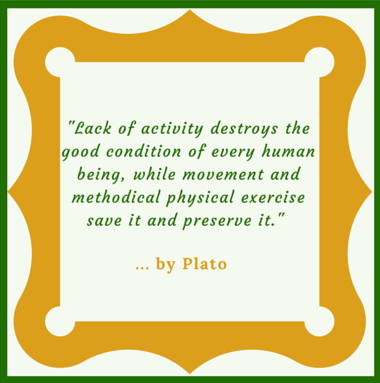Orthocellular Nutrition and Exercise Inc.
Find Time for Exercise: The Lifestyle Solutions
FAQ #18: Can't find time for exercise? Now you can! One way is to fine tune your time management. This is eighteenth frequently asked question in our series.
A. Answering the Question
If you are currently experiencing a time crunch throughout the day and are in a constant state of hurry, this frequently asked question is definitely for you. In terms of your overall fitness level, nothing is as important as finding time for exercise. And you need to be consistent in your approach.
Is it that important?
Yes! Our frames are built for movement in our lives. With over 600+ muscles, 200+ bones, and a whole lot of connective tissue holding everything in place, you gotta move it or you will lose it.
Unless you make time and maintain your fitness level as you age, a lack of exercise and movement will change your body in a number of detrimental ways including a:
Gain in body fat,
Distorted body composition,
Loss of lean muscle mass,
Reduction in bone density,
Loss of functional movement,
Drop in joint flexibility,
Development of poor posture and postural deviations,
Stiffening of the fascial network and connective tissue,
Shortening of hamstring and hip flexor muscles,
Drop in lung strength,
Loss of aerobic capacity for supplying oxygen to the body,
Reduction in heart muscle size, and
Drop in heart strength.
In addition, your sleep, stress, cleansing ability, and nutritional status are also adversely affected.
In the mainstream, misinformation and half-truths prevail when it comes to the information about the correct exercise and proper movement that you need on a daily basis. You are presented with a series of fragments that work to keep you confused and in the dark.
B. Providing the Solutions for Can't Find Time for Exercise
Can't find time for exercise? Now you can! Check out these handy resources below. They will get you back on the right track!
Fine Tune your Time Management
There are 24 hours in each day. Eight hours are for work, eight hours are for sleeping, and eight hours are for other activities. After meal preparation, eating, and family duties, the average person has about two hours left for exercise. This is the time you don't want to waste.
Spread your exercise sessions throughout the day. Perhaps 30 minutes mid-morning, 30 minutes in the early afternoon, and 30 minutes in the late afternoon or early evening may work for you. Be consistent with your times each day. And shoot for six days of activity per week. Take the seventh day off.
Here is what the poet Goethe says about commitment: "Until one is committed, there is always hesitancy, the chance to draw back, always ineffectiveness ... The moment one definitely commits oneself, then providence moves too ... Whatever you can do or dream you can, begin it. Boldness has genius, power and magic in it."
Get informed about Exercise with these Articles
For a series of related articles, head over to the Exercise Articles page now, which is also under the Exercise Room in the column to your right.
Here is Jim's story about how to find time for exercise ...
Looking back on my life before 2008, I was actually living in an unbalanced state when it came to my physical fitness. There was lots of activity in the winter from downhill skiing and tons of movement in the summer from inline skating, but nothing in between. There were too many months of inactivity in between these periods of sport and recreation.
This approach is not in sync with what the body actually needs to maintain physical fitness. The body starts to regress at the muscular level 3 to 6 weeks after the cessation of a seasonal sport or recreation. And, the gains that were made during the season are lost. This is not a good situation to be in as we age.
In addition, there was also an imbalance physically in my body at the muscular, skeletal, and connective tissue levels. This was due to a strong lower body, a somewhat weak trunk and core, and an even weaker upper body. Also, not a good situation going forward.
First Key: During 2008 and beyond I learned how to incorporate physical activity into my life 6 days a week and 10 to 11 months of the year. This was the first key to re-balancing my body. I realized that our bodies are crying our for consistent movement, but not any old movement. It has to be weight-bearing and bone-loading activities, which provide the stimuli for new muscle and bone growth.
Second Key: The second key to re-balancing my body was from removing the muscle imbalances I had created over the years in the upper regions of my body. I now have a body that is strong and balanced, front-and-back, side-to-side, and head-to-toe from total body conditioning.
Third Key: The final key stems from learning to impart balance in your workouts each day, which is what I call the Balanced Exercise Program (BEP). This is where you split your program into three sessions each day. Each session takes 30 to 45 minutes to complete. In this way, you are working the cardio-respiratory system through interval routines in the mid-to-late morning to enhance your lung power, heart strength, and lower body muscularity, a combination mind-body session such as deep breathing followed by pilates and/or yoga in the mid-afternoon for muscle balancing, core strengthening, and postural gains, and a resistance training session in the late afternoon or early evening to build and/or maintain muscle, bone, and connective tissue to enhance upper body endurance, strength, and size in men or definition in women.
When you split your routines up throughout the day, it is much easier to find the time to workout. After putting a BEP in place, I am certain you will feel so good about yourself and have so much extra energy that you will always find time for exercise in the future.
 A quotation from Plato addressing the FAQ Find Time for Exercise. Yes, you need movement and exercise to maintain your body. When you realize that then finding time should be easy.
A quotation from Plato addressing the FAQ Find Time for Exercise. Yes, you need movement and exercise to maintain your body. When you realize that then finding time should be easy.
Checkpoint ...
Return to the top of this page: Find Time for Exercise
Return to the FAQs index: FAQs Index Page
Caring is sharing ....
Four Pillars
of
Health
Pillar #1
Nutrition Protocols
Visit the Nutritionist's Kitchen
Pillar #2
Exercise Routines
Go to the Exercise Room
Pillar #3
Stress Reduction
Techniques
Head over to the Stress Reduction Place
Pillar #4
Detoxification
Methods
Check out the Detox Centre
Preventative
Health Contract Services
Business
and
Industry
Educational
Institutions
Health
Agencies
Preventative
Health Business Opportunities
Four Pillar
Licences
Two Pillar
Licences
Image Galleries
Click one of the thumbnails below to view a series of photos taken on the Bruce Trail and Georgian Bay.
E-publications
Our E-books
Workshops
Free Workshops
Spring 2026
Go to: Free Workshops
Blog
The Preventative Way
with
Mr. Prevention
On The Preventative Way page we reveal a number of scientific facts related to how we function at the cellular level to keep our bodies healthy. Visit this page often as new facts, quotes, videos, tips, and traps will be added from time to time.
Go to: The Preventative Way
Connect with Us
on Facebook
Visit the American Council on Exercise
American Council on Exercise offers four certifications for aspiring fitness professionals including their Certified Personal Trainer (ACE-CPT) designation. Click on the ACE logo to find out all about their programs and certifications..
The Leap Manifesto
A call for a Canada based on caring for the Earth and one another is the message on this organization's site.
Click on the above logo to read the manifesto and then sign it. Orthocellular supports this initiative because it is about positive change for the people and the environment that we all share. The changes need to start now!








